by78
General
According to this , the improved Long March 8 variant will have its maiden flight in June of 2024.
Compared to the basic LM-8, the improved variant will have a larger diameter final stage (increased from 3m to 3.34m) and a larger fairing (increased from 4.2m to 5.2m).

The 3.35m-diameter final stage (driven by the 10-ton Lox/LH2 YF-75H engine) of the improved Long March 8 has recently completed a full-system test run.




































